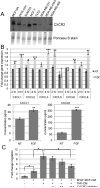Macrophages promote fibroblast growth factor receptor-driven tumor cell migration and invasion in a CXCR2-dependent manner
- PMID: 22893608
- PMCID: PMC3553584
- DOI: 10.1158/1541-7786.MCR-12-0275
Macrophages promote fibroblast growth factor receptor-driven tumor cell migration and invasion in a CXCR2-dependent manner
Abstract
Infiltration of immune cells, specifically macrophages, into the tumor microenvironment has been linked to increased mammary tumor formation and progression. Activation of growth factor receptor signaling pathways within mammary epithelial cells, such as the fibroblast growth factor receptor 1 (FGFR1) pathway, induces recruitment of macrophages to the mammary epithelium. These macrophages promote increased epithelial cell proliferation and angiogenesis. However, the specific mechanisms by which these macrophages are regulated by the preneoplastic epithelial cells and the mechanisms of action of the macrophages within the developing FGFR1-driven tumor microenvironment remain unknown. In this study, we show that activation of inducible FGFR1 in mammary glands leads to decreased activity of the TGFβ/Smad3 pathway in macrophages associated with early stage lesions. Further studies show that macrophages have increased expression of inflammatory chemokines that bind Cxcr2 following exposure to conditioned media from mammary epithelial and tumor cells in which the FGF pathway had been activated. The increase in these ligands is inhibited following activation of the TGFβ pathway, suggesting that decreased TGFβ signaling contributes to the upregulation of these chemokines. Using coculture studies, we further show that macrophages are capable of promoting epithelial and tumor cell migration and invasion through activation of Cxcr2. These results indicate that macrophage-derived Cxcr2 ligands may be important for promoting mammary tumor formation regulated by FGFR signaling. Furthermore, these results suggest that targeting Cxcr2 may represent a novel therapeutic strategy for breast cancers that are associated with high levels of infiltrating macrophages.
Figures






Similar articles
-
Fibroblast growth factor receptor 1 activation in mammary tumor cells promotes macrophage recruitment in a CX3CL1-dependent manner.PLoS One. 2012;7(9):e45877. doi: 10.1371/journal.pone.0045877. Epub 2012 Sep 24. PLoS One. 2012. PMID: 23029290 Free PMC article.
-
Human pituitary tumor-transforming gene 1 overexpression reinforces oncogene-induced senescence through CXCR2/p21 signaling in breast cancer cells.Breast Cancer Res. 2012 Jul 12;14(4):R106. doi: 10.1186/bcr3226. Breast Cancer Res. 2012. PMID: 22789011 Free PMC article.
-
Transcriptional responses to direct and indirect TGFB1 stimulation in cancerous and noncancerous mammary epithelial cells.Cell Commun Signal. 2024 Oct 28;22(1):522. doi: 10.1186/s12964-024-01821-5. Cell Commun Signal. 2024. PMID: 39468555 Free PMC article.
-
The role of activin in mammary gland development and oncogenesis.J Mammary Gland Biol Neoplasia. 2011 Jun;16(2):117-26. doi: 10.1007/s10911-011-9214-4. Epub 2011 Apr 8. J Mammary Gland Biol Neoplasia. 2011. PMID: 21475961 Review.
-
ErbB/EGF signaling and EMT in mammary development and breast cancer.J Mammary Gland Biol Neoplasia. 2010 Jun;15(2):191-9. doi: 10.1007/s10911-010-9172-2. Epub 2010 Apr 6. J Mammary Gland Biol Neoplasia. 2010. PMID: 20369376 Free PMC article. Review.
Cited by
-
Hyaluronan, Inflammation, and Breast Cancer Progression.Front Immunol. 2015 Jun 8;6:236. doi: 10.3389/fimmu.2015.00236. eCollection 2015. Front Immunol. 2015. PMID: 26106384 Free PMC article. Review.
-
CXCR2: a target for pancreatic cancer treatment?Expert Opin Ther Targets. 2013 Jun;17(6):667-80. doi: 10.1517/14728222.2013.772137. Epub 2013 Feb 21. Expert Opin Ther Targets. 2013. PMID: 23425074 Free PMC article. Review.
-
In Vitro Models for Studying Invasive Transitions of Ductal Carcinoma In Situ.J Mammary Gland Biol Neoplasia. 2019 Mar;24(1):1-15. doi: 10.1007/s10911-018-9405-3. Epub 2018 Jul 28. J Mammary Gland Biol Neoplasia. 2019. PMID: 30056557 Free PMC article. Review.
-
Interaction between human osteosarcoma and mesenchymal stem cells via an interleukin-8 signaling loop in the tumor microenvironment.Cell Commun Signal. 2018 Apr 6;16(1):13. doi: 10.1186/s12964-018-0225-2. Cell Commun Signal. 2018. PMID: 29625612 Free PMC article.
-
Cancer Stem Cells and Macrophages: Implications in Tumor Biology and Therapeutic Strategies.Mediators Inflamm. 2016;2016:9012369. doi: 10.1155/2016/9012369. Epub 2016 Feb 14. Mediators Inflamm. 2016. PMID: 26980947 Free PMC article. Review.
References
-
- de Visser KE, Eichten A, Coussens LM. Paradoxical roles of the immune system during cancer development. Nat Rev Cancer. 2006;6(1):24–37. - PubMed
-
- Bingle L, Brown NJ, Lewis CE. The role of tumour-associated macrophages in tumour progression: implications for new anticancer therapies. J Pathol. 2002;196(3):254–65. - PubMed
-
- Pollard JW. Tumour-educated macrophages promote tumour progression and metastasis. Nat Rev Cancer. 2004;4(1):71–8. - PubMed
Publication types
MeSH terms
Substances
Grants and funding
LinkOut - more resources
Full Text Sources
Other Literature Sources
Medical
Miscellaneous

